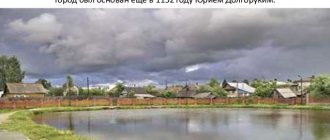Card index of fiction in the senior group according to the Federal State Educational Standard with goals
Card index of fiction in various educational fields in the senior group According to the program “From birth to school”, ed.
N.E. Veraksy O.O. Contents Author, title Purpose Moral education RNS “The Fox and the Jug” arr. O. Kapitsa Cultivating good feelings; formation of ideas about greed and stupidity RNS “Winged, hairy and oily” arr. I. Karnaukhova Teach children to understand the character and actions of the heroes of X. Mäkel. "Mr. Au" (chapters), trans. from Finnish E. Uspensky rns "Khavroshechka" arr. A. N. Tolstoy Cultivate manifestations of good feelings towards each other; RNS "Bragging Hare" arr. O. Kapitsa To educate the norms of moral behavior rns “The Frog Princess” arr. M. Bulatov Cultivate kindness and a sense of mutual assistance. B. Shergin “Rhymes” Cultivate a respectful attitude towards other people rns “Sivka-burka” arr. M. Bulatov To develop in children the ability to evaluate the actions of heroes, to express their attitude towards them RNS “Finist-Clear Falcon” arr. A. Platonov Cultivate a sense of compassion for others V. Dragunsky “Childhood Friend”, “Top down, diagonally” Cultivate attentiveness, love, compassion for a close comrade S. Mikhalkov “What do you have?” Nenets fairy tale “Cuckoo” arr. K. Sharov To promote kindness, attentiveness and responsiveness to relatives “Goldilocks”, trans. from Czech K. Paustovsky; cultivate the ability to empathize, be generous, and not envy others; develop self-respect and mutual assistance in work. "Three golden hairs of Grandfather the Omniscient", trans. from Czech N. Arosieva (from the collection of fairy tales by K. Ya. Erben). V. Dmitrieva. “Baby and the Bug” (chapters) Feel and understand the character of the images of L. Tolstoy’s literary work “The Bone” Cultivate the moral qualities of the individual: honesty, truthfulness, love for family. L. Tolstoy “The Jump” To awaken in children empathy for the hero of the story N. Nosov. "Living Hat"; To form children's ideas about moral standards with the help of children's literature. S. Georgiev. “I saved Santa Claus” Develop the ability to evaluate one’s own actions and the actions of heroes, cultivate friendliness, and the ability to interact with peers A. Lindgren. “Carlson, who lives on the roof, has arrived again” (chapters, abbr.), trans. with Swedish L. Lungina K. Paustovsky. “The Thief Cat” To cultivate moral qualities: a sense of compassion, empathy Adam Mitskevich “To Friends” To generalize and expand children’s knowledge about such concepts as “friend”, “friendship”, “honesty”, “justice” P. Bazhov “Silver Hoof” To educate a feeling of kindness, caring for the weak R. Kipling. "Little Elephant", trans. from English K. Chukovsky, poems in translation. S. Marshak To foster a culture of behavior, friendship, mutual assistance, care for loved ones V. Kataev. “Tsvetik-semitsvetik” To develop the ability to present the characteristics of one’s personality among peers, reflecting achievements and the reasons for possible difficulties. Child in the family and in society RNS "Khavroshechka" arr. A. N. Tolstoy Introduce different family relationships by Yu. Koval “Grandfather, Grandmother and Alyosha” Form in children an idea of a family as people who live together, love each other, take care of each other. V. Dragunsky “Deniska’s stories” Formation of ideas about the characteristic qualities of boys and girls. A. Gaidar. “Chuk and Gek” (chapters) Learn to assess the relationships between close people in the family, compile characteristics of the heroes of E. Grigoriev’s “Quarrel” Develop the basics of social interaction between boys and girls; a friendly attitude towards the opposite sex A. Barto “Vovka is a kind soul” E. Blaginina “Let’s sit in silence” Continue to form children’s idea of a kind attitude towards their mother A. Usachev “What is etiquette” Continue teaching the culture of verbal communication in kindergarten and at home “Krupenichka” N. Teleshov Cultivate interest in fairy tales, in Russian traditions Self-service, work RNS “Khavroshechka” arr. A. N. Tolstoy To form children’s ideas about a hardworking person K. Chukovsky “Moidodyr” Education of cultural and hygienic skills K. Chukovsky “Fedorino’s grief” rns “At the command of the pike” To consolidate in children the concept of the importance of human labor A. Barto “The grimy girl” » Cultivate neatness and careful attitude towards personal belongings and belongings of Comrade Yu. Tuvim. “A letter to all children on one very important matter,” trans. from Polish S. Mikhalkova Formation of the foundations of security S. Mikhalkov “Uncle Styopa the policeman” Reinforcing the rules of behavior on the streets of the city E. Segal “Cars on our street” Cognitive development of FEMP Reading books Heroes of fairy tales S. Marshak “Numbers” Acquaintance with numbers Acquaintance with the social world G H. Andersen “Snowman” Introduction to New Year’s traditions of different countries S. Mikhalkov “What do you have?” Introduction to the importance of any profession "Wonderful stories about a hare named Lek", tales of the peoples of West Africa, trans. O. Kustova and V. Andreeva; Acquaintance with the characteristics of the peoples of West Africa A. Gaidar “The Tale of a Military Secret, Malchish-Kibalchish and His Firm Word” Continue to expand children’s ideas about the Russian army. Nenets fairy tale “Cuckoo” arr. K. Sharov Acquaintance with the life of the peoples of the far north M. Boroditskaya “Waiting for a brother” To form a desire to take care of children, to develop a sense of responsibility and respect for younger comrades A. Tvardovsky “The Tankman’s Story” To form in children an idea of the feat of the people who stood up for the defense of their Motherland . A. Barto “The Herd Game” Expand children’s knowledge about their kindergarten, draw attention to its history, clarify ideas about the work of kindergarten employees S. Makhotin “Senior group” O. Vysotskaya “Kindergarten” T. Aleksandrova “Kuzka the Brownie” (chapters) Cultivate interest in the life of Russians in ancient times, love for the history of their people M. Isakovsky “Go beyond the seas and oceans” Clarify knowledge about your native country. B. Almazov. “Gorbushka” Introduction to Russian values; Introduction to the natural world rns “Bragging Hare” arr. O. Kapitsa To form children’s caring attitude towards nature, the desire to take part in its conservation and protection. L. Tolstoy. “Lion and Dog”, “Bone”, “Jump” Expand ideas about the life of animals G. Snegirev “Penguin Beach” K. Paustovsky. “Cat Thief” Foster love and respect for nature, kindness; V. Bianchi “Owl” Continue to form an idea of the interconnection and interdependence of living beings, an idea of the literary genre “educational fairy tale”; B. Zakhoder “Gray Star” To cultivate a sense of empathy and love for nature and man, the ability to resist evil S. Yesenin “Bird cherry” To help feel the beauty of nature in R. Kipling’s poem. "Little Elephant", trans. from English K. Chukovsky, poems in translation. S. Marshak Develop fine motor skills of the hands, attention and interest in the animal world and its diversity P. Bazhov “Silver Hoof” Cultivate a sensitive attitude towards animals, love for nature Speech development Development of all aspects of speech Acquaintance with genres Explanation of unfamiliar, outdated words Artistic and aesthetic development Introduction to art V. Konashevich Acquaintance with illustrators I. Bilibin E. Charushin Fine arts activity Drawing illustrations based on works Musical activity P. I. Tchaikovsky “The Nutcracker” (fragments) Acquaintance with the musical depiction of heroes and images of works by P. I. Tchaikovsky “The Seasons” (fragments) N. A. Rimsky-Korsakov “The Tale of Tsar Saltan” (fragments) S. Prokofiev “Peter and the Wolf” Physical development of GCD and leisure activities based on the plots of the works Heroes of the works
Download Card index of fiction in the senior group according to the Federal State Educational Standard
We recommend watching:
Notes for a math lesson in the senior group “Kolobok's Journey” Notes on speech development in the senior group “Poultry” Intellectual Olympiad for senior preschool children in kindergarten Consultation for preschool teachers. Development of sound culture of speech in older children
Similar articles:
Cultivating cognitive interest in social reality in children of senior preschool age
Surprising moments in kindergarten classes. Card index
Kindergarten teacher business card
Presentation of kindergarten for parents
Morning exercises in kindergarten in the preparatory group
How to conduct classes on fairy tales
First of all, you need to think in advance what the teacher wants to develop in children in a particular lesson. It is the setting of the goal and task that determines what stories will be covered in the lesson. For example, “The Frog Princess” will help in developing kindness and understanding. She will be able to tell you that not everything is actually what it seems. What seems terrible and disgusting on the outside can turn out to be beautiful in reality. A similar moral can be found for every fairy tale. That is why it is important that the child understands what the work is about.
Important! In addition to such a specific task, there are also those that must be implemented in every lesson. This is the development of the ability to retell, the development of vocabulary, the development of logically constructed thoughts and the cultivation of a love for fairy tales. It is interesting that nurturing love for them also affects the general character of children.
Next you need to prepare the office. It should be colorful and interesting for children. Pictures must be related to the topic of the lesson.
After this, you should take care of the handouts. Each work is well reinforced by the game. Therefore, you need to think about which game or production will be most interesting and effective for children. In addition, you need to come up with questions about the content of the work. In addition, it doesn’t hurt to buy a collection of fairy tales in advance.
Only by being well prepared can you create a lesson that will be interesting to children and will be remembered by them for its positive emotions. Various online services may be useful for preparation. With their help, you can also arrange watching cartoons.
Math corners in kindergartens and their design
Peculiarities of perception by older preschoolers
In addition to the development of coherent speech, reading literature to older preschoolers has the following features:
- the use of various genres: fairy tale, story, poem and others;
- the use of games and dramatizations, theatrical performances, didactic games on the topic of the read work;
- the need for preparatory work before reading the work, as well as the need for subsequent discussion of the actions of the characters;
- use of visual aids: paintings, illustrations.
Visibility when reading literature
The peculiarities of perception in older preschoolers are that they can more vividly perceive dynamic works, comic poems, and fairy tales. The attention of older preschoolers is not yet stable enough, so reading must be done intermittently.
Healthy! Children at this age can already be aware of some events, even those that have not yet occurred in personal experience. They are interested not only in the actions of the heroes and their assessment from the bad or good side, but also the motives of such actions, the feelings of the heroes. More developed children are able to grasp the author's context.
Didactic games on FEMP in the preparatory group
At older preschool age, children can already perceive text. Here, both the understanding of the literary hero and the understanding of some stable turns of the fairy tale become more complicated. It is at an older age that the child’s mechanism for studying the holistic image of a text is already actively functioning. At the same time, reliance on visualization is not always necessary, but it is a significant aid for children in understanding the essence of the text.
All the skills in working with fiction acquired by children of senior preschool age will help in the future in elementary school. Developed coherent speech, the ability to analyze a work and identify the main characters, evaluate their feelings - this is what a teacher should strive for in teaching older groups.





